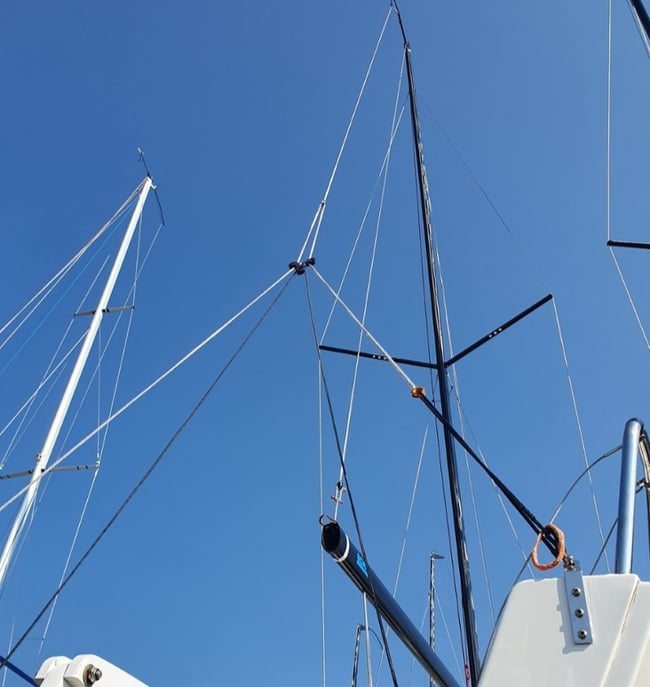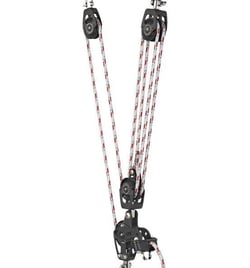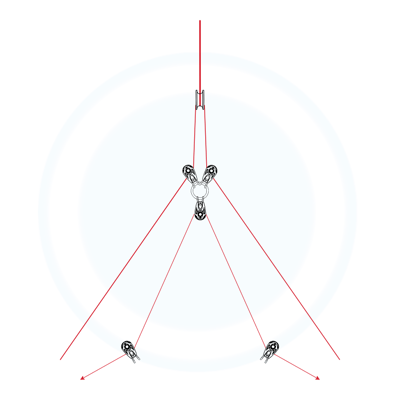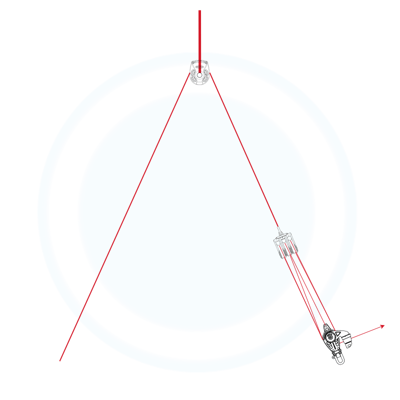
We have previously reported on the benefits of composite backstays: to reduce weight aloft and increase performance. An effective control system to finely tune backstay load is equally important, particularly for a race yacht. In this blog we look at 3 popular configurations for backstay purchase systems using block and tackle.
What is purchase?
The mechanical advantage of a system is referred to as purchase. This is the multiplying factor between the input and output forces. For example, the below image shows a 6:1 purchase system using block and tackle. Note that we are ignoring friction.

Image credit: Antal
How much purchase do you need?
The amount of purchase needed of course depends on the backstay load and with how much ease you want to be able to adjust it.
Given the complexity of trying to predict backstay load we can instead approach this from the other direction and look at how much force we can expect to input to the system. This helps us to match the amount of purchase to the size of blocks used. The amount of force you are able to input to the system of course depends on many factors, but a good ballpark for most people is 30kg pulling on a rope. Multiplying this by the purchase gives us a rough idea of the output force. Therefore, to achieve a backstay load of 500kg requires at least 16:1 purchase.
30-38ft race yacht – 48:1 purchase

This is a high-power backstay system allowing fine-tune control for race yachts up to 40ft. Twin control lines allow trimming from each side of the cockpit. The attachment points are usually close together in the centre of the transom.
This system uses 3 cascades for 8:1 purchase which is then multiplied by 6:1 using a triple block on the upper end and a double block plus two single blocks on deck. The first cascade uses a high-load roller-bearing block to reduce friction and the following two cascades use thimbles for simplicity and to minimise cost.
Example system for 38ft yacht:
|
Item |
Min. SWL |
Block |
Line |
|
Primary |
1400kg |
||
|
Cascade 1 |
700kg |
||
|
Cascade 2 |
350kg |
||
|
Cascade 3 |
175kg |
Connects to 6:1 purchase |
|
|
6:1 purchase |
175kg |
Harken 40mm Carbo Air, triple, double and single:
Harken 40mm Carbo Block - Triple + Swivel
Harken 40mm Carbo Double Swivel Block
|
This setup can be easily modified to 32:1 by swapping the triple block for a double and the double block for a single. Alternatively, 24:1 can be achieved by removing one of the cascades.
Small keelboat – triangle backstay

An elegant, simple setup commonly found on small sportsboats like J70 which allows fine tune control. This setup has minimal hardware and connects to the edges of the transom. Twin controls allow trimming from both sides of the cockpit.
Mechanical advantage is created by compressing the backstay triangle rather than with multiple cascades or a traditional block and tackle. The triangle is made of singlebraid Dyneema running through a thimble on the single part of the backstay. The tensioning blocks are 3 small ball bearing blocks connected to a ring.
23ft sportsboat example:
|
Item |
Min. SWL |
Block |
Line |
|
Primary |
500kg |
||
|
Triangle |
|
||
|
Control |
125kg |
|
Course tune can be added at one side of the triangle with an adjustable sliding splice or a lashing.
Cruiser up to 35ft – 12:1 split backstay

A basic split backstay setup for small cruisers up to 35ft which offers 12:1 purchase. The split backstay connects to each side of the transom which keeps the cockpit clear for stern-to mooring or in case of a diving platform. The control line is at one side of the cockpit only for less frequent adjustment.
The split part of the backstay is effectively a single cascade running through a high-load block or thimble on the end of the primary part of the backstay. One side of the cascade is connected to a 6:1 purchase formed using triple blocks. An integrated cam cleat means no additional hardware is required.
35ft cruiser example:
|
Item |
Min. SWL |
Block |
Line |
|
Primary |
1200kg |
|
|
|
Triangle |
600kg |
Connects to 6:1 purchase |
|
|
6:1 purchase |
600kg |
Antal 50mm OPF triple and triple with becket and cleat:
Antal OPF Triple Block Ø50 with Shackle
Antal OPF Triple Block Ø50 with Becket, Cam Cleat and Shackle
|
|
More purchase can be added by integrating another cascade on one side of the triangle for 24:1.
Summary
We have looked at 3 different backstay options along with a hardware example for a given boat size. In all cases the exact configuration depends on the boat and it is always possible to increase or decrease the amount of purchase to suit.
If you have any questions please feel free to email us at support@upffront.com, or click the link below to see our full range:


